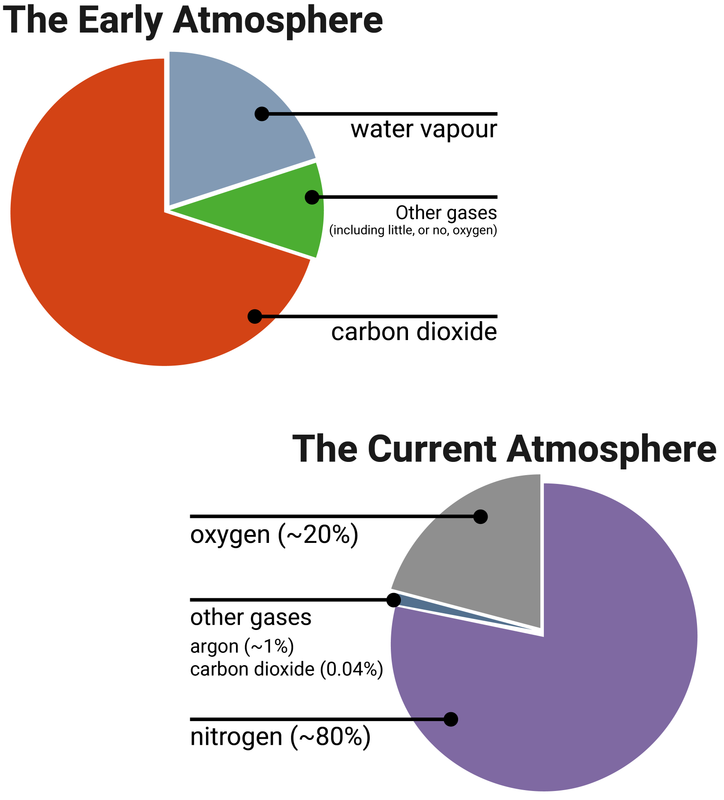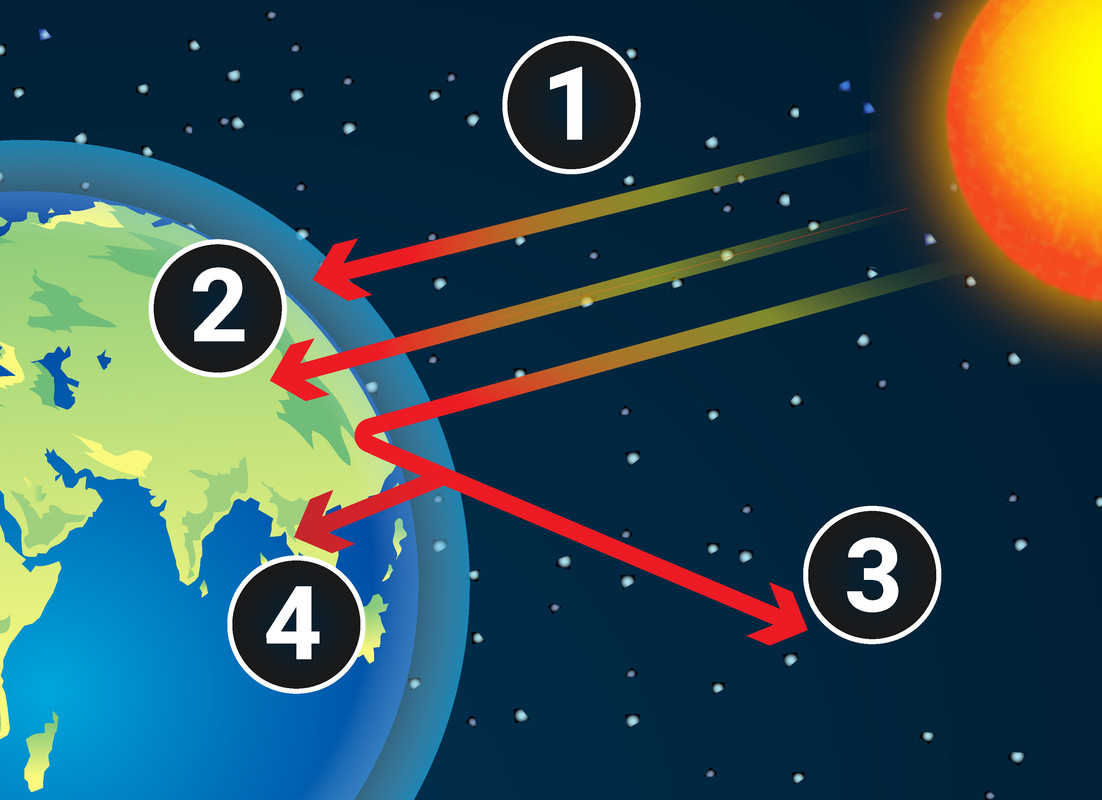
Chemistry of the Atmosphere
Earth's Atmosphere
The early atmosphere
Theories about what was in the Earth’s early atmosphere and how the atmosphere was formed have changed and developed over time. Evidence for the early atmosphere is limited because of the time scale of 4.6 billion years.
One theory suggests that during the first billion years of the Earth’s existence there was intense volcanic activity that released gases that formed the early atmosphere and water vapour that condensed to form the oceans. At the start of this period the Earth’s atmosphere may have been like the atmospheres of Mars and Venus today, consisting of mainly carbon dioxide with little or no oxygen gas.
Volcanoes also produced nitrogen which gradually built up in the atmosphere and there may have been small proportions of methane and ammonia.
Over time the amount of carbon dioxide in the air was reduced. One way was by the gas dissolving in newly formed oceans, forming carbonates. These then precipitated into sediments, formed fossil fuels, or sea creatures used the dissolved carbon dioxide to form shells made of calcium carbonate.
Another way that the levels of carbon dioxide decreased was due to the growth of algae and primitive plants that used this carbon dioxide for photosynthesis, which consequently produced oxygen - gradually increasing the amount of oxygen in the atmosphere.
carbon dioxide + water → glucose + oxygen
6CO2 + 6H2O → C6H12O6 + 6O2
Over a few billion years plants evolved and the percentage of oxygen increased to a level that enabled animals to evolve. This nearly killed all other life on the planet, because of how reactive oxygen can be. This is referred to as The Great Oxygenation event.

Greenhouse Effect
Greenhouse gases in the atmosphere maintain temperatures on Earth high enough to support life. Water vapour, carbon dioxide and methane are all greenhouse gases. They absorb heat radiated from the Earth, subsequently releasing energy which keeps the Earth warm: this is known as the greenhouse effect
- Short wavelength radiation from the Sun passes through the atmosphere
- The radiation hits the Earth's surface, where some of its energy is absorbed (warming the Earth)
- The lower energy radiation is reflected back (now long wavelength)
- Greenhouse gases in the atmosphere absorb this long wavelength radiation (warming the Earth)
- This causes an increase in temperature.
Short wavelength radiation refers to:
- Ultraviolet (UV)
- Visible light
- Near infrared (IR)
Long wavelength radiation refers to longer wavelength infrared (IR).

Greenhouse gases:
- carbon dioxide (CO2)
- methane (CH4)
- water (H2O)
Human Activities
Based on peer-reviewed evidence, many scientists believe that human activities (releasing lots of greenhouse gases) will cause the temperature of the Earth’s atmosphere to increase resulting in global climate change. Modelling this is difficult, because climate change is a complex issue. This leads to simplified models, speculation, and opinions that are expressed in the media that may be based on only parts of the evidence and can be biased.
Since about 1850, there has been an increase in the burning of fossil fuels for energy and industry. During this time the world's carbon dioxide levels have been increasing, and since we know burning fossil fuels releases carbon dioxide - this is very good evidence that the two are related.
As the levels of carbon dioxide have increased, the average temperature of the Earth's surface has also risen. Whilst there is a strong correlation between the two, correlation doesn't necessarily mean there is a causal link (one thing causes the other) between the two.
Scientists have been able to show in the lab that carbon dioxide absorbs infrared ratiation, and satellites have been able to show that as carbon dioxide levels have increased - less infrared radiation has left the Earth's atmosphere.
Evaluating the evidence
Evidence for historical carbon dioxide levels come from measuring the concentrations of gases trapped in ice cores, the oldest coming from Antartica (with data going back 800,000 years).
The oldest temperature records for central England date back to 1659, but cannot be used to assess global temperature changes as they are only from one place. Temperature records from around the world have only existed from about 1880. These measurements were also not very accurate.
Climate Change
Methane is a much more powerful (some scientists say up to four times more) greenhouse gas than carbon dioxide, as it is better at absorbing infrared radiation. Methane is the main component of natural gas, and is released into the atmosphere when oil and natural gas are extracted from the ground and then processed.
Livestock (mainly cattle) also produce a lot of methane gas because of the bacteria in their stomachs during digestion. There are similar bacteria found in landfill sites, as well as rice fields.
Effects of climate change
Rising temperatures due to the increase of carbon dioxide and methane in the atmosphere will lead to:
- ice at the South Pole and in glaciers will melt, causing global sea levels to rise - this will lead to increased, and/or permanent flooding in some areas
- animals will move away from their 'natural' habitats to find cooler areas to live, and some plants/animals may become extinct if they cannot survive the warmer temperatures
- weather patterns will begin to change with some areas becoming drier, and others much wetter - and even more extreme weather events like more frequent severe storms and heat waves/droughts
- wildlife, and growth of crops, will be affected by the ever-changing weather systems
- as more carbon dioxide is released, more will dissolve into water systems lowering the pH - more acidic waters can harm the organisms that live in them

Limiting the impact
Using renewable energy sources can reduce greenhouse gas emissions, although it may not undo the damage already done.
Some people have suggested either collecting carbon dioxide and burying it, or reflecting infrared radiation back into space.
Reducing the impact is probably only a temporary fix, but involves building flood defences, dams, and irrigation systems. These will probably destroy habitats, and will not fix the issues - only cover up the symptoms of a much bigger problem.
Carbon Footprint
The carbon footprint is the total amount of carbon dioxide and other greenhouse gases emitted over the full life cycle of a product, service or event.
The carbon footprint can be reduced by reducing emissions of carbon dioxide and methane. Here are some of the ways that governments can reduce our carbon footprint:
- capture, and store, carbon - carbon dioxide gas from power stations can be stored underground
- increase/introduce taxes - penalise companies/individuals for releasing too many greenhouse gases
- carbon off-setting - plant more trees (reforestation) to convert carbon dioxide into oxygen
- carbon neutrality - companies introduce methods, such as planting trees, to take out as much carbon dioxide as they put into the atmosphere. Overall the amount of carbon entering the atmosphere would be zero
There are many things you can do to reduce your personal carbon footprint:
- use more alternative energy supplies, often referred to as 'green energy'
- reduce your energy consumption, and/or increase energy efficiency, in your home
- reduce your use of cars, or increase the fuel efficiency
- car share or use public transport, to reduce the amount of road vehicles
Overcoming issues
Despite the very real threat of climate change, there are still some issues getting in the way of fixing it:
- whole world participation - there is no use 50% of the world trying to change, but the other 50% keeps producing large amounts of greenhouse gases
- public information and education - not enough is being done to clearly explain the issue
- scientific disagreement - often you'll see "97% of scientists agree", and often those that deny climate change is due to human activities will cling to the "3%"
- money - who's going to pay for all this change?
Pollutants From Fuels
The combustion of fuels is a major source of atmospheric pollutants.
When a fuel is burned it releases many gases into the atmosphere. These gases can include:
- carbon monoxide (CO)
-
This is a toxic invisible gas, and it preferentially binds to haemoglobin in red blood cells instead of oxygen. This reduces the amount of oxygen carried in the bloodstream, causing affected people to feel sleepy or to become unconscious. Severe poisoning can even cause death.
- carbon particulates (soot, C)
-
This can block pipes carrying away waste gases from an appliance. It will blacken buildings, and it can cause breathing problems if it collects in the lungs.
Particulates can also contribute to global dimming, reducing the amount of sunlight that reaches the Earth's surface. - sulfur dioxide (SO2)
-
Sulfur impurities in fossil fuels, like coal and crude oil, can react with oxygen when the fuels are burned to produce sulfur dioxide gas. This gas can dissolve in rain water to produce acid rain, which damages structures, and wildlife habitats such as lakes and forests.
- nitrogen oxides (NOx)
-
When fuels are burned in engines, oxygen and nitrogen from the air can react together at high temperatures to produce oxides of nitrogen. These can also dissolve in rain water to produce acid rain.
Nitrogen dioxide is a red-brown toxic gas, and can cause respiratory diseases like bronchitis. Catalytic converters in cars convert most of the NOx gases back to harmless nitrogen.
Some oxides of nitrogen react with other pollutants to form harmful 'photochemical smog'.